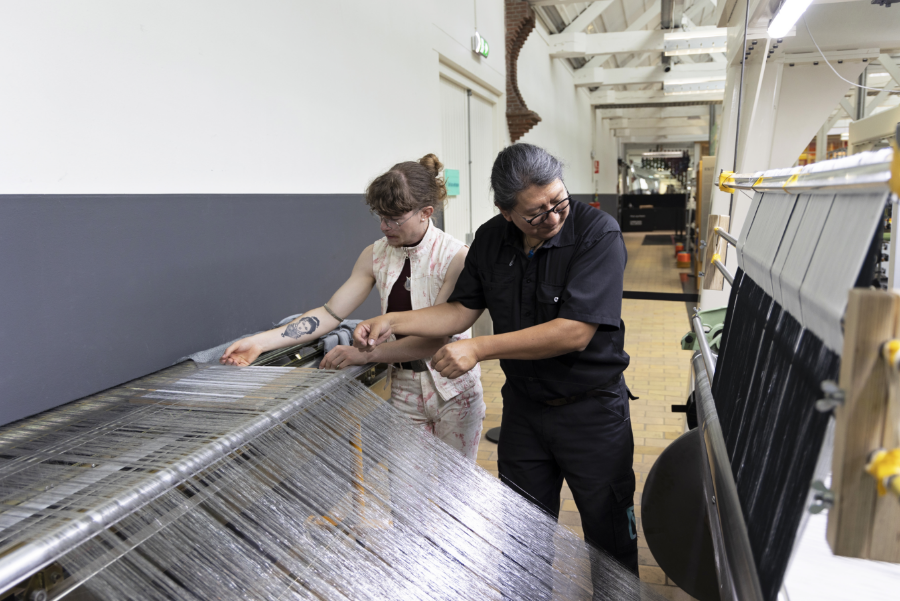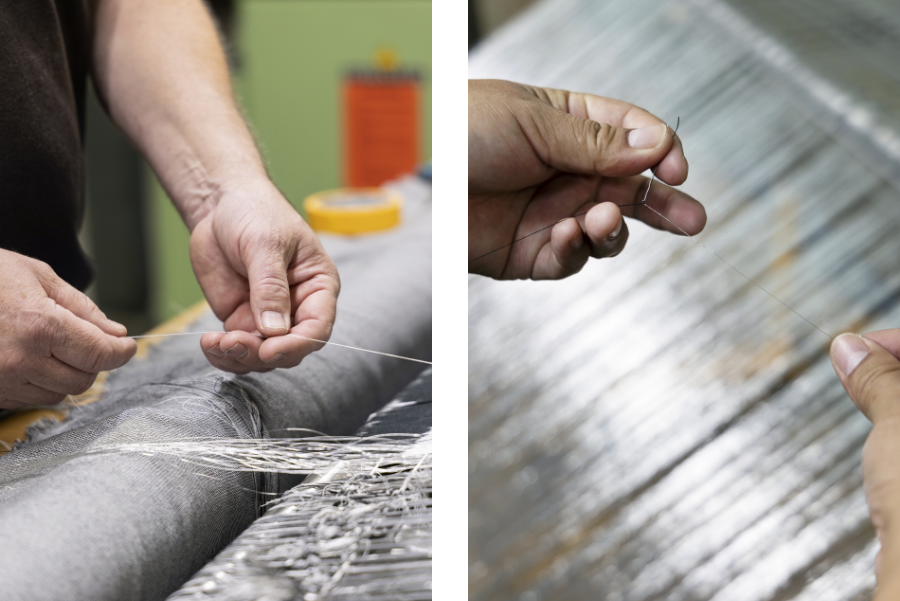We did it: the 170-centimetre-wide jacquard loom has a new warp – made of aluminium. This first in the weaving industry marks a major step forward in the lab’s ‘weaving with metal’ R&D programme. The modified machine is being tested this month.
Frans Verbunt’s grandfather worked in the Mommers & Co textile factory for 40 years, on the spot where the Sample Studio is now located. Verbunt inherited his name and in a sense his job from his grandfather. Eighteen years ago, he joined the TextielLab as a graphic printer. About six years ago, he followed in his family’s footsteps by becoming a weaver. When asked about the highlights from that period, he recalls the enormous curtains for the National Library in Qatar and the LocHal in Tilburg, warping the loom for Queen Máxima’s King’s Day cape and inaugurating the new 353-centimetre-wide ‘Number 4’ jacquard loom with Otobong Nkanga’s museum collection commission. But none of these was as innovative as the project that Verbunt has just completed: putting an aluminium warp on the Dornier 170 loom. “As far as we know, this has never been done before on a jacquard loom.”
Knotting machine
This milestone marks the start of a new phase in the R&D programme that the TextielLab has been working on with DRIFT for the past two years. Following the promising aluminium samples that product developer Judith Peskens made on the semi-industrial TC2 weaving machine, we are now scaling up to the computer-controlled 170-centimetre-wide Dornier loom. Warping the loom was an experiment in itself. The loom normally gets a new warp every month – either because the warp beam is empty or because the warp is changed from cotton to Trevira CS or polyester monofilament. That is done mechanically. Verbunt produces an expensive warp knotting machine from a trunk that does the job in about a day.

The weavers during the tying process of the warp. Photo: Josefina Eikenaar
Manual warping
But the knotting machine couldn’t handle the metal knots, so replacing the Trevira CS warp with an aluminium one had to be done by hand. Knotting and threading 6,120 warp threads manually takes time, especially if the thread curls and snaps if you don’t thread and tighten it properly. Even with the help of fellow weavers Alonso Muenala, Michel Leermakers and Koen Giesen (intern) , it took Verbunt several weeks of intense work to complete the warp: “We did about 1 cm per hour.”
“As far as we know, this has never been done before.”
Frans Verbunt
Stronger springs
The knotting process wasn’t the only thing that was different, says Gerard Kuijpers, technology and implementation manager. The jacquard loom had to be modified technically to prevent it from getting stuck on the aluminium warp. Due to the stiffness of the metal, 6,120 new, stronger springs were also needed to pull down each warp thread individually. The machine’s normal weaving speed was also reduced to avoid risks.

The first metal samples will be made this month. Photos: Josefina Eikenaar
New samples
This month, product developer Judith Peskens will oversee the production of the first samples. The team will test existing designs with both a conventional yarn weft and a metal weft. The weavers are not worried about the loom, which they say can cope. “We’re curious to see how stiff the samples will be, because we can weave with more density per centimetre. Our aim is to make a structure with this material, and it’s exciting to see whether that will work. It’s something we’ll be keeping a close eye on in the coming months,” says Peskens.
Text: Willemijn de Jonge